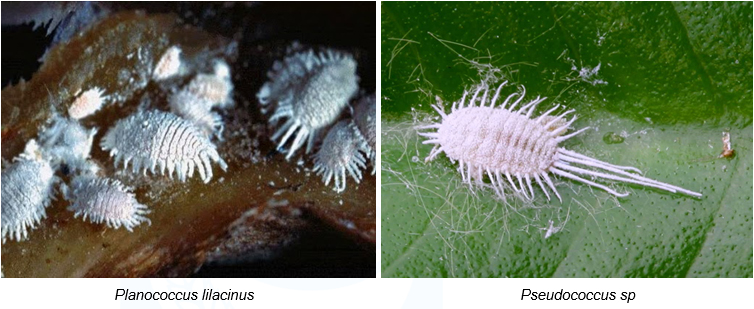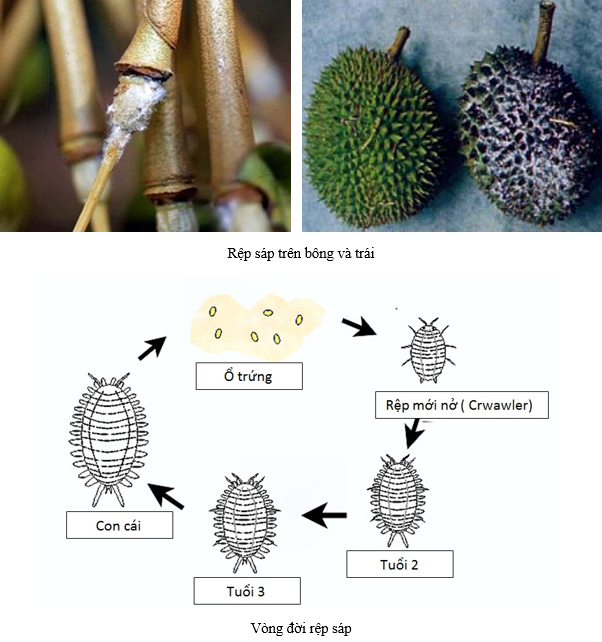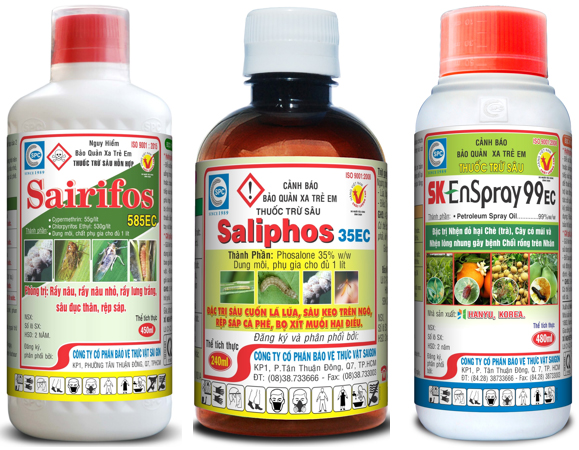|
Durian damaging mealybug
29/01/2022
MSc Huynh Kim Ngoc Harmful agents: Planococcus sp, Pseudococcus. Belongings to order: Hemiptera, family: Pseudococcidae Biological and harmful properties: On durian, there are many types of mealybugs, mainly appearing and causing damage on fruit,flower , and rarely on leaves. Female mealybugs have a body about 3 mm long, pink or yellow, with a white powdery coating on the outside. Eggs are laid in clusters of 100 - 200 eggs, a female can lay 600 - 800 eggs. After 6-10 days, the eggs hatched, the baby mealybugs (crawler) are pale yellow, smooth, not covered with white powder. They quickly seek shelter and cause harm. Male mealybugs are smaller than females, molt 4 times, have wings, whereas female mealybugs only molt 3 times, then lay eggs and die, female mealybugs have no wings. Mealybugs increase in density very quickly, reproducing 2-3 times a year. Mealybugs cause damage by sucking sap from young fruit stalks or between spines on large fruit. When the fruit is young, if mealybug density is high, the fruit will be deformed and fall off; if the fruit is large, the fruit will develop poorly and become hardened. When there is a lack of food, mealybugs take refuge in the soil in the root zone. Mealybugs suck the sap and excrete a sugar-rich fluid, which makes it easier for sooty mold to grow and leaves the fruit covered with a layer of black soot. Durian fruits that appear sooty mold and mealybugs do not look good, are difficult to sell, and have low prices. In addition, fungi also make plants grow poorly due to reduced photosynthesis. Mealybugs are less mobile and live in symbiosis with ants. Ants live by sucking the secretions released by mealybugs and protect the mealybugs by driving away the predators and parasites of the mealybugs, after the mealybugs have sucked up all the sap, the ants will carry the mealybugs elsewhere to continue causing harm. . Mealybugs have many natural predators such as ladybugs and parasites such as bees that parasitize eggs.
Attention stage: Flowering and fruiting stages. Measures to prevent mealybugs: - Do not plant thickly. Clean the garden regularly, prune branches to create ventilation. The branches and fruits that are strongly attacked by mealybugs should be pruned and brought out of the garden to destroy, the fruits that grow in clusters need to be pruned so that the mealybugs have no place to hide. - Take care of healthy plants. - Spray water with high pressure nozzle. - Regularly check the garden to detect and timely spray insecticides, especially at the stage of flowering and fruiting development. To kill bed mealybugs can use one of the products such as Sairifos 585EC, Saliphos 35EC. To increase the effectiveness of control and reduce the amount of pesticides, the above products can be combined with SK Enspray 99EC mineral oil. Be sure to spray with plenty of water and see the instructions on the label before use. |
To prevent, in addition to plowing and burying weed seeds, collecting weed stalks and stumps left after tilling the land to burn, not letting weeds produce seeds in production fields, etc., the use of chemical products is still a measure. optimal because of its ability to thoroughly kill weeds, reduce labor and take advantage of more time than manual weeding.
Miner has the scientific name Phyllocnistis citrella Staint., family Phyllocnistidae, order Lepidoptera. The miner occurs in many countries in the tropics and subtropics. The main host of the miner is the citrus family - Rutaceae. In addition, the miner also attacks mangosteen and some other plants.
Adult is a small planthopper, with a body 2-3 mm long, the whole body is ash gray, slightly greenish, the wings are opaque with many small brown spots.Eggs are oval, 0.3 mm long, have a pointed end and are attached directly to the leaf surface, leaf axils.
Green bugs specialize in the fruit of citrus groups (oranges, tangerines, lemons, grapefruits, kumquats...), some people call them orange bugs, or orange suckers. Their scientific name is Rhynchocoris poseidon or Rhynchocoris humeralis.
In Vietnam, yellow leaf curl disease is very common on papaya trees, especially the disease is often severe in areas of high and continuous planting, areas with hot and arid climates. The disease has significantly reduced the yield and quality of papaya. Gardens that are infected early when the plants are young may not yield. However, up to now, many gardeners still do not know the cause and how to fix it.
Spider mites are common pests on citrus trees, especially in hot and dry climates that are suitable for spiders to grow and cause severe damage.The group of harmful spiders is usually very small in size, unlike the natural enemy spiders.
This group includes species that are generally very small in size, causing damage by sucking plant sap (on leaves, fruits, branches, stems).
There are many species of mealybugs present on the group of Oranges,Tangerines,Grapefruits and Lemons (Citrus), which can be divided into 2 groups:
+ Group of sticky mealybugs with common varieties such as Lepidosaphes, Aonidiella, Coccus and Saissetia.
+ Group of flower mealybugs with common genera and species such as Pseudococcus, Planococcus and Icerya purchasi.
Dry branches and berries disease often appear to be common damage on coffee gardens during the rainy season. The disease causes death of branchs, dry fruit, severely affects the canopy structure and coffee yield if not paid attention to prevention.
Pink disease commonly causes diseases on rubber plantations in the rainy season, especially on garden from 4-8 years old. This year, rubber has to go through a period of severe drought, weakening the tree, so now in tnshe rainy season it is easy to get infected. Therefore, it is necessary to pay attention to good management to avoid affecting the garden.
In recent years, the area of citrus has been expanded because it is a fruit tree with high economic efficiency. However, in order to sell at a high price, not only in quality but consumers also require the external beauty of the fruit, so pest management on citrus is a matter of great concern to farmers. The hot season is a favorable condition for thrips to develop and cause damage, affecting the commercial value of fruit.
- Headquarters
- SAIGON PLANT PROTECTION JOINT STOCK COMPANY
- RQ 1, Nguyen Van Quy St., Tan Thuan Ward, HCM City
- Tax code: 0300632232
- Tel: (028) 38 733 295 - 38 732 077
- Fax: (028) 38 733 003 - 38 733 391
- Website: www.spchcmc.vn - Email: info@spchcmc.vn
- SAIGON PLANT PROTECTION COMPANY
- SAIGON PLANT PROTECTION JOINT STOCK ENTERPRISE
- Lot C1-C3 Hiep Phuoc Industrial Park, Hiep Phuoc Commune, HCM City
- Tel: (028) 3873 4089 - Fax: (028) 3873 4086
- Affiliated Unit
-
- Quick Links
- Home
- About us
- Career Opportunities














